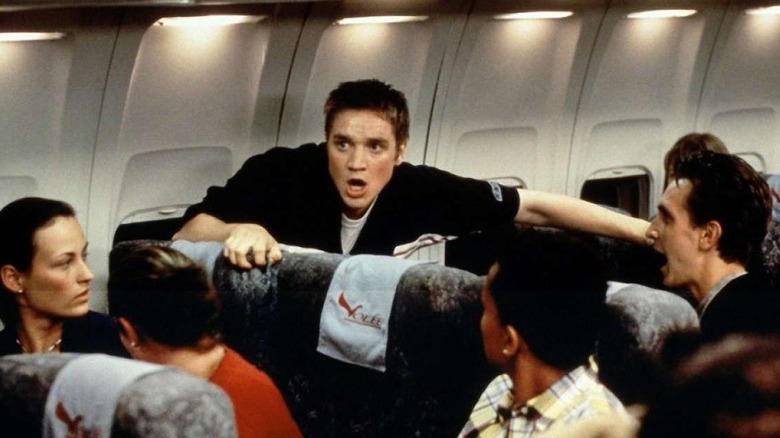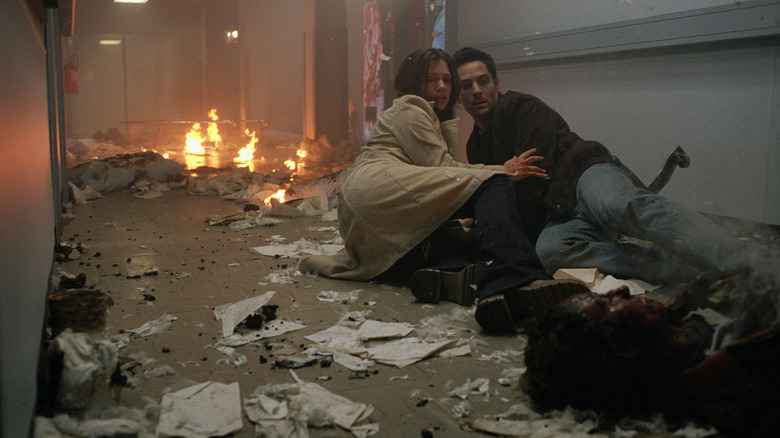All Of The Final Destination Movies Ranked By Box Office
We may receive a commission on purchases made from links.
As far as horror franchises born in the 2000s go, it's hard to find a bigger, more enduring example than that of "Final Destination." The property is really only rivaled by the $1 billion juggernaut that is "Saw" in that regard. Still, pound for pound, movie for movie, this particular franchise has been remarkably consistent for 25 years now, and it's even gotten a new lease on life in 2025 (which is somewhat ironic, considering it's centered around Death as a strategic, merciless killer).
Created by writer Jeffrey Reddick and starting life as an "X-Files" spec script, "Final Destination" hit theaters in 2000 and helped to usher horror into the new millennium. While each of the movies has its own characters, story, and creative set pieces, the entire franchise is centered around the idea that nobody can cheat Death. Those who do will find themselves on the wrong side of this unstoppable force of nature as it seeks to right a perceived wrong.
For more than a decade, the franchise ruled the box office before "Final Destination 5" brought things full circle and, for a time, to a close in 2011. However, "Final Destination Bloodlines" very successfully revived the series for a new generation, paving the way for more to come. But which of these movies had the biggest impact at the box office? How has the property fared over the years, financially speaking?
We're going to look at that from every angle, ranking the "Final Destination" series by box office, both by actual grosses and accounting for inflation. Then, we'll look at what all of these numbers tell us. Let's dive in.
The Final Destination movies ranked by unadjusted box office
First, we're going to look at what each of the "Final Destination" movies made at the box office, in total, including re-releases, and rank them using the pure amount of money that they each grossed. These numbers do not account for inflation. They were gathered using various databases, including Box Office Mojo and The Numbers, using the highest reported gross for each entry. Also of note, these are worldwide grosses, meaning they include both domestic and international figures. With that said, here's how it all shakes out:
-
"Final Destination Bloodlines" (2025) – $285.3 million
-
"The Final Destination" (2009) — $187.3 million
-
"Final Destination 5" (2011) — $157.8 million
-
"Final Destination 3" (2006) — $118.8 million
-
"Final Destination" (2000) — $112.8 million
-
"Final Destination 2" (2003) – $90.9 million
As we can see, there is a clear winner — and it's not even close. This year's "Final Destination Bloodlines" absolutely killed it at the box office. The 14-year absence from the big screen really seemed to benefit the franchise, allowing fans to build up a real appetite for it and evolving the property into a multigenerational hit, not altogether unlike "Jurassic World" in 2015. It also helped that directors Adam Stein and Zach Lipovsky delivered the goods.
Taking that outlier out of it, though, we can see that "Final Destination 2," which is widely considered the best entry in the franchise, is also the lowest-grossing installment. However, relative to its reasonable budget, it was still a big hit for New Line Cinema at the time. Hence, we got a lot more sequels, with the grosses generally growing over the life of the franchise with no meaningful dips. That's rare for a property that has been going this long.
The Final Destination movies ranked by inflation-adjusted box office
Next, we're going to adjust each movie's total take at the box office accounting for inflation to see how that changes things. To get the adjusted numbers, I used the U.S. Inflation Calculator and entered the original total for each film, marking the year it came out, and calculating what that would translate to in 2025. It's important to remember that these numbers will fluctuate as time goes on. This is merely a snapshot of what this looks like now, but it's nonetheless an important demonstration of how inflation can change things. Here's how it shakes out:
-
"Final Destination Bloodlines" (2025) — $285.3 million
-
"The Final Destination" (2009) — $282 million
-
"Final Destination 5" (2011) — $226.6 million
-
"Final Destination" (2000) — $211.6 million
-
"Final Destination 3" (2006) — $190.3 million
-
"Final Destination 2"(2003) — $159.5 million
As we can see, there is very little change in the order. Even with the inflation adjustment, 2009's "The Final Destination," widely considered the worst entry in the franchise, couldn't quite take the crown away from "Bloodlines." It's also worth pointing out that the poor reception to "The Final Destination" helps explain the dip for "Final Destination 5," despite it being a well-liked movie. Other than that, the list is almost identical to the unadjusted ranking, save for "Final Destination" and "Final Destination 3" swapping places.
How much did each of the Final Destination movies cost to make?
Before looking at the larger findings, we need to look at the budgets for each of the "Final Destination" movies. When it comes to box office, it's all relative. A movie can make $400 million at the box office, but if it costs $250 million to make, it's still a losing proposition. So, it's important to understand how the cost/benefit shakes out for each of these movies as well. We're going to go over the budgets for each of the movies in the franchise, both unadjusted and adjusted for inflation to offer a more thorough look:
-
"Final Destination" — $23 million unadjusted/$43 million adjusted
-
"Final Destination 2" — $26 million unadjusted/$45 million adjusted
-
"Final Destination 3" — $25 million unadjusted/$40 million adjusted
-
"The Final Destination" — $40 million unadjusted/$60 million adjusted
-
"Final Destination 5" — $40 million unadjusted/$57 million adjusted
-
"Final Destination Bloodlines" — $50 million unadjusted/$50 million adjusted
The big takeaway is that Warner Bros. and New Line have generally kept things sensible relative to the size of the movies they were making. Even adjusting for inflation, these films have never risen above the upper-mid-budget level. Rather, these are low-to-mid-budget propositions that have paid off every single time. The profits were never kneecapped by an out of control budget, which happened with some of the later "Star Trek" movies. The word here is consistency.
What do these numbers tell us about the Final Destination movies?
The biggest thing that stands out when looking at all of the numbers is that few franchises can compete with the sheer consistency of "Final Destination." The budgets have been consistent and the box office hauls have been consistently great, with an overall upward trend. The fact the property is bigger than it's ever been without a hard reboot after 25 years is very impressive. Almost any horror franchise that has been around that long would have been rebooted in some way by this point.
It certainly doesn't hurt that the vast majority of primary characters die in each movie, allowing for a creative reset of sorts each time around. The other big takeaway is that perceived quality really matters. "The Final Destination" may have been a big hit financially in 2009, but the poor response to that movie hurt "Final Destination 5." Recovering from those creative hiccups isn't always easy.
With the state of the global box office on uncertain ground, it's not a surprise that Warner Bros. finally decided to bring "Final Destination" back. One might look at that 14-year gap and think it left money on the table, but that gap may well have helped make "Bloodlines" the success that it is. Sometimes, it's simply better to leave audiences wanting more and let them get hungry for it. That can pay off handsomely when executed correctly.
You can grab the "Final Destination" 6-film collection on Blu-ray or DVD from Amazon.




